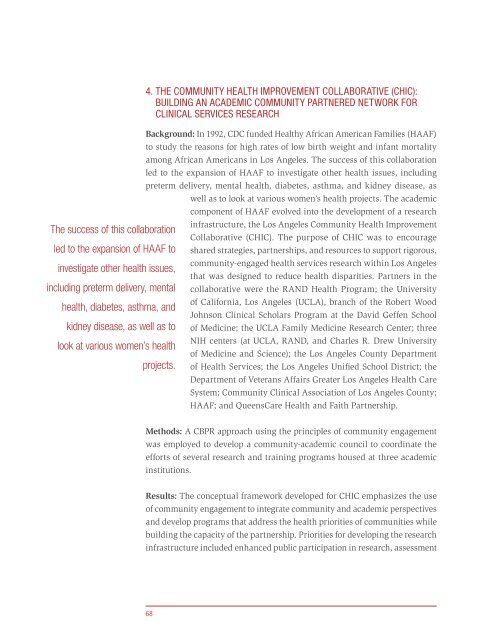Principles of Community Engagement (Second Edition)
Principles of Community Engagement (Second Edition)
Principles of Community Engagement (Second Edition)
Create successful ePaper yourself
Turn your PDF publications into a flip-book with our unique Google optimized e-Paper software.
The success <strong>of</strong> this collaboration<br />
led to the expansion <strong>of</strong> HAAF to<br />
investigate other health issues,<br />
including preterm delivery, mental<br />
health, diabetes, asthma, and<br />
kidney disease, as well as to<br />
look at various women’s health<br />
projects.<br />
4. THE COMMUNITY HEALTH IMPROVEMENT COLLABORATIVE (CHIC):<br />
BUILDING AN ACADEMIC COMMUNITY PARTNERED NETWORK FOR<br />
CLINICAL SERVICES RESEARCH<br />
Background: In 1992, CDC funded Healthy African American Families (HAAF)<br />
to study the reasons for high rates <strong>of</strong> low birth weight and infant mortality<br />
among African Americans in Los Angeles The success <strong>of</strong> this collaboration<br />
led to the expansion <strong>of</strong> HAAF to investigate other health issues, including<br />
preterm delivery, mental health, diabetes, asthma, and kidney disease, as<br />
well as to look at various women’s health projects The academic<br />
component <strong>of</strong> HAAF evolved into the development <strong>of</strong> a research<br />
infrastructure, the Los Angeles <strong>Community</strong> Health Improvement<br />
Collaborative (CHIC) The purpose <strong>of</strong> CHIC was to encourage<br />
shared strategies, partnerships, and resources to support rigorous,<br />
community-engaged health services research within Los Angeles<br />
that was designed to reduce health disparities Partners in the<br />
collaborative were the RAND Health Program; the University<br />
<strong>of</strong> California, Los Angeles (UCLA), branch <strong>of</strong> the Robert Wood<br />
Johnson Clinical Scholars Program at the David Geffen School<br />
<strong>of</strong> Medicine; the UCLA Family Medicine Research Center; three<br />
NIH centers (at UCLA, RAND, and Charles R Drew University<br />
<strong>of</strong> Medicine and Science); the Los Angeles County Department<br />
<strong>of</strong> Health Services; the Los Angeles Unified School District; the<br />
Department <strong>of</strong> Veterans Affairs Greater Los Angeles Health Care<br />
System; <strong>Community</strong> Clinical Association <strong>of</strong> Los Angeles County;<br />
HAAF; and QueensCare Health and Faith Partnership<br />
Methods: A CBPR approach using the principles <strong>of</strong> community engagement<br />
was employed to develop a community-academic council to coordinate the<br />
efforts <strong>of</strong> several research and training programs housed at three academic<br />
institutions<br />
Results: The conceptual framework developed for CHIC emphasizes the use<br />
<strong>of</strong> community engagement to integrate community and academic perspectives<br />
and develop programs that address the health priorities <strong>of</strong> communities while<br />
building the capacity <strong>of</strong> the partnership Priorities for developing the research<br />
infrastructure included enhanced public participation in research, assessment<br />
68

















